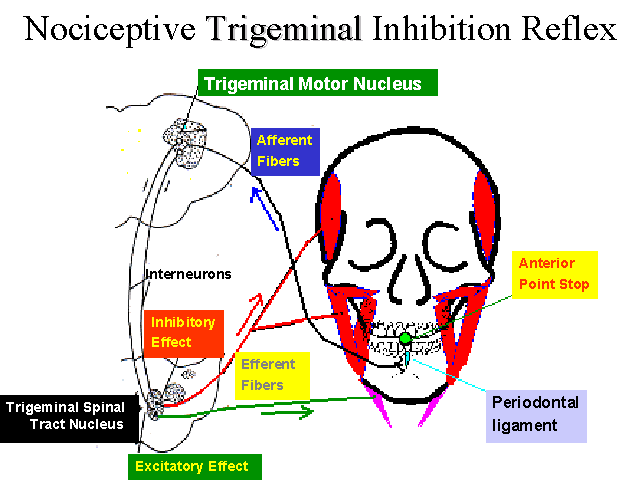Here's what's happening. Your lower front teeth (called incisors) are
designed to warn you that what you're about to eat may be too hard to chew
on. Whenever the lower incisors are put under moderate to severe pressure,
they signal the temporalis muscles to relax before pain and damage can
happen to them. This is called the jaw-opening-reflex. It is designed to
prevent you from putting something too hard into your mouth that may be
damaging to your back molar teeth. The back molars, on the other hand,
do practically the opposite. Whenever something comes in contact with them
(like frozen-solid Snickers Bars, a piece of bone, or TMJ splints), the
back molars signal the jaw-closing muscles to bite down hard because they
figure, since there's something between them; it must be time to chew!

The NTI-tss device takes advantage of the jaw-opening reflex by only
allowing contact to be made on only one or two of the lower front teeth
(incisors), and never allowing any of the back teeth (or canine teeth)
to touch. (The prevention of allowing canine and posterior teeth from contacting
is probably just as important as the lone contact on the incisors. The
research shows that the contacting of either the canine or posterior
teeth instantly allows a significant increase in temporalis contraction.)
Thus, when the mouth is being closed, a lower incisor will touch the NTI-tss
appliance, suppressing the temporalis muscles' ability to contract! Of
course, the NTI-tss appliance cannot be worn when actual eating and chewing
are taking place.
We tension headache and common migraine sufferers have developed a habit of pressing some or all of our teeth together when we are concentrating on something. We may squeeze our teeth together just a little bit or go for a full-on clench. Our jaw may be lined up in the middle, or we may hold it off to the side a bit, and we have no idea we're doing it. By definition, we usually have absolutely no awareness of our habit. No one else is aware that we're doing anything abnormal because our clenching (whatever the degree) is a silent and motionless act (espencially when sleeping, unlike "grinding" of teeth).
There are two versions of the NTI-tss appliance, one for sleeping, and one for when awake. Daytime clenching activity by itself really doesn't cause anything, but acts as an irritant to pre-existing condition…one that was developed while asleep. Wearing the daytime appliance for a month or so (except when chewing) allows us to have a more intimate awareness of our habit and most importantly, frequently allows the signal to be sent to supress the musculature (every time you "tap" on the device). Although clenching activity during sleep is impossible to stop, the nighttime NTI-tss device allows for a suppressed, or reduced intensity of muscle contraction (which may also by a funtion of not allowing for canine and posterior teeth to touch). It's important to point out that in the muscular parafunction world, it's the intensity of contraction that creates and perpetuates the symptoms. I find myself biting on my nighttime appliance when I wake up, however, I don't have a headache because the NTI-tss reduces the intensity of clenching, thus preventing the headache.
It's during certain stressful parts of the day (like during scary movies, driving, balancing your checkbook, when the sympathetic nervous system makes its presence felt.) and especially at night, when high intensity temporalis contraction occurs that the NTI-tss appliance is worn. Essentially, the NTI-tss appliance is a simple habit-breaking device for daytime, and prevents the sleep disorder of intense temporalis contraction at night.
During the research and development of the NTI-tss, we did an electro-myo-graph (EMG) study of the temporalis muscle. An EMG records the intensity of a muscle contraction by measuring the electrical activity through the muscle during the contraction. We wanted to know how the maximum clenching intensity of the temporalis would be affected by the NTI-tss appliance as compared to using a traditional "TMJ" appliance.
Twenty-two patients who woke up with headaches were selected. Maximum clenching activity of the temporalis was recorded on each patient by placing the EMG electrode pads on the patient's temporalis muscle and having the patient clench his/her teeth as hard as he/she could. All of the patients were then fitted with a NTI-tss appliance and asked to clench into it as hard as they could. On average, the patient's muscle contraction was reduced to one-third (33%) of maximum. Each patient was then fitted with the TMJ flat-plane splint and asked to clench into the splint as hard as possible. On average, patients were able to clench at 104% of maximum! This means headache patients who have myofascial pain dysfunction of the temporalis can actually intensify their condition when using the traditional TMJ splint! (Our studies were to confirm previous studies.)
What if you believe that your headaches are different and are caused by a sinus condition or some food allergy and are not somehow associated with muscle contraction?...KEEP READING.
"At 82 years old, I'd been having constant headaches and migraines for more years than I'd like to remember. It was absolutely marvelous to find relief after just two weeks of using the NTI Tension Suppression System. I promised myself I'd give Dr. Boyd a big hug when I saw him, but since I already paid him, I figured we're even!" Edith Pratt, Escondido, CA